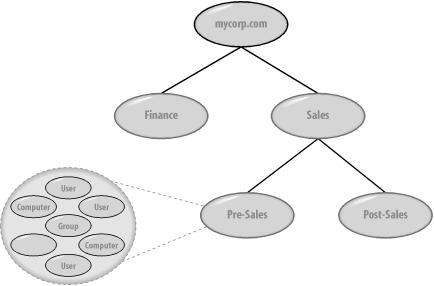Chapter 2. Active Directory Fundamentals
This chapter aims to bring you up to speed on the basic concepts and terminology used with Active Directory. It is important to understand each component of Active Directory before embarking on a design, or your design may leave out a critical element.
How Objects Are Stored and Identified
Data is stored within Active Directory in a hierarchical fashion similar to the way data is stored in a filesystem . Each entry is referred to as an object. At the structural level, there are two types of objects: containers and non-containers, also known as leaf nodes. One or more containers branch off in a hierarchical fashion from a root container. Each container may contain leaf nodes or other containers. A leaf node, however, as the name implies, may not contain any other objects.
Consider the parent-child relationships of the containers and leaves in Figure 2-1. The root of this tree has two children, Finance and Sales. Both of these are containers of other objects. Sales has two children of its own, Pre-Sales and Post-Sales. Only the Pre-Sales container is shown as containing additional child objects. The Pre-Sales container holds user, group, and computer objects as an example.[1] Each of these child nodes is said to have the Pre-Sales container as its parent. Figure 2-1 represents what is known in Active Directory as a domain.

Figure 2-1. A hierarchy ...
Get Active Directory, Second Edition now with the O’Reilly learning platform.
O’Reilly members experience books, live events, courses curated by job role, and more from O’Reilly and nearly 200 top publishers.

